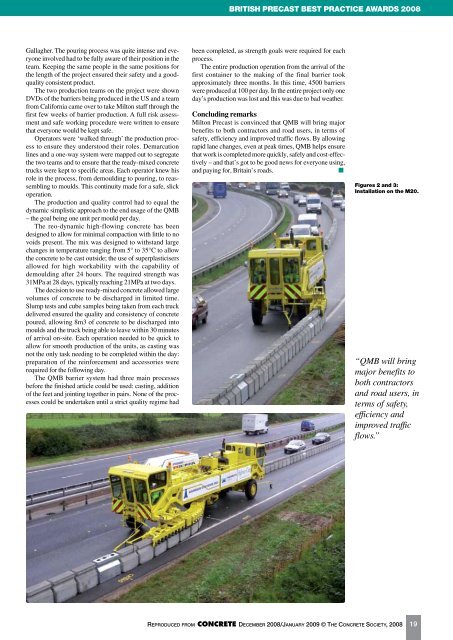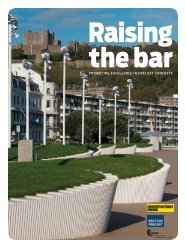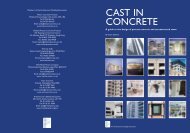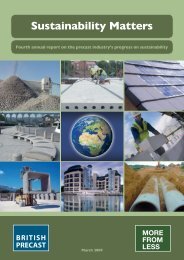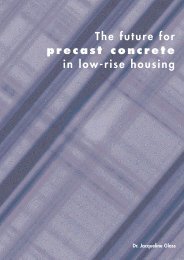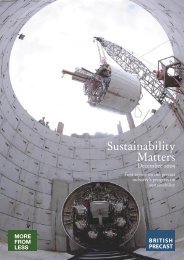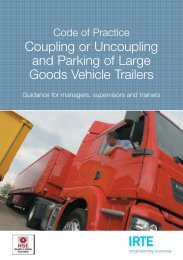The voice of concrete products - British Precast
The voice of concrete products - British Precast
The voice of concrete products - British Precast
You also want an ePaper? Increase the reach of your titles
YUMPU automatically turns print PDFs into web optimized ePapers that Google loves.
BRITISH PRECAST BEST PRACTICE AWARDS 2008<br />
Gallagher. <strong>The</strong> pouring process was quite intense and everyone<br />
involved had to be fully aware <strong>of</strong> their position in the<br />
team. Keeping the same people in the same positions for<br />
the length <strong>of</strong> the project ensured their safety and a goodquality<br />
consistent product.<br />
<strong>The</strong> two production teams on the project were shown<br />
DVDs <strong>of</strong> the barriers being produced in the US and a team<br />
from California came over to take Milton staff through the<br />
first few weeks <strong>of</strong> barrier production. A full risk assessment<br />
and safe working procedure were written to ensure<br />
that everyone would be kept safe.<br />
Operators were ‘walked through’ the production process<br />
to ensure they understood their roles. Demarcation<br />
lines and a one-way system were mapped out to segregate<br />
the two teams and to ensure that the ready-mixed <strong>concrete</strong><br />
trucks were kept to specific areas. Each operator knew his<br />
role in the process, from demoulding to pouring, to reassembling<br />
to moulds. This continuity made for a safe, slick<br />
operation.<br />
<strong>The</strong> production and quality control had to equal the<br />
dynamic simplistic approach to the end usage <strong>of</strong> the QMB<br />
– the goal being one unit per mould per day.<br />
<strong>The</strong> reo-dynamic high-flowing <strong>concrete</strong> has been<br />
designed to allow for minimal compaction with little to no<br />
voids present. <strong>The</strong> mix was designed to withstand large<br />
changes in temperature ranging from 5° to 35°C to allow<br />
the <strong>concrete</strong> to be cast outside; the use <strong>of</strong> superplasticisers<br />
allowed for high workability with the capability <strong>of</strong><br />
demoulding after 24 hours. <strong>The</strong> required strength was<br />
31MPa at 28 days, typically reaching 21MPa at two days.<br />
<strong>The</strong> decision to use ready-mixed <strong>concrete</strong> allowed large<br />
volumes <strong>of</strong> <strong>concrete</strong> to be discharged in limited time.<br />
Slump tests and cube samples being taken from each truck<br />
delivered ensured the quality and consistency <strong>of</strong> <strong>concrete</strong><br />
poured, allowing 8m3 <strong>of</strong> <strong>concrete</strong> to be discharged into<br />
moulds and the truck being able to leave within 30 minutes<br />
<strong>of</strong> arrival on-site. Each operation needed to be quick to<br />
allow for smooth production <strong>of</strong> the units, as casting was<br />
not the only task needing to be completed within the day:<br />
preparation <strong>of</strong> the reinforcement and accessories were<br />
required for the following day.<br />
<strong>The</strong> QMB barrier system had three main processes<br />
before the finished article could be used: casting, addition<br />
<strong>of</strong> the feet and jointing together in pairs. None <strong>of</strong> the processes<br />
could be undertaken until a strict quality regime had<br />
been completed, as strength goals were required for each<br />
process.<br />
<strong>The</strong> entire production operation from the arrival <strong>of</strong> the<br />
first container to the making <strong>of</strong> the final barrier took<br />
approximately three months. In this time, 4500 barriers<br />
were produced at 100 per day. In the entire project only one<br />
day’s production was lost and this was due to bad weather.<br />
Concluding remarks<br />
Milton <strong>Precast</strong> is convinced that QMB will bring major<br />
benefits to both contractors and road users, in terms <strong>of</strong><br />
safety, efficiency and improved traffic flows. By allowing<br />
rapid lane changes, even at peak times, QMB helps ensure<br />
that work is completed more quickly, safely and cost-effectively<br />
– and that’s got to be good news for everyone using,<br />
and paying for, Britain’s roads.<br />
n<br />
Figures 2 and 3:<br />
Installation on the M20.<br />
“QMB will bring<br />
major benefits to<br />
both contractors<br />
and road users, in<br />
terms <strong>of</strong> safety,<br />
efficiency and<br />
improved traffic<br />
flows.”<br />
Reproduced f ro m CONCRETE December 2008/January 2009 © <strong>The</strong> Concrete So c i e t y, 2008 19


